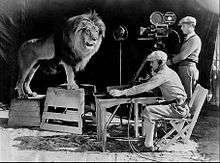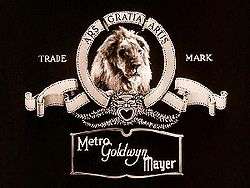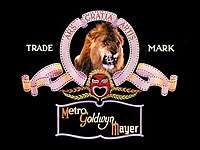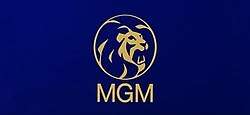Leo the Lion (MGM)
Leo the Lion is the mascot for the Hollywood film studio Metro-Goldwyn-Mayer and one of its predecessors, Goldwyn Pictures, featured in the studio's production logo, which was created by the Paramount Studios art director Lionel S. Reiss.[1]

Since 1916 and through the time the studio was formed by the merger of Samuel Goldwyn's studio with Marcus Loew's Metro Pictures and Louis B. Mayer's company in 1924 there have been seven different lions used for the MGM logo. Although MGM has referred to all of the lions used in their trademark as "Leo the Lion", only the current lion, in use since 1957 (a total of 63 years), was actually named "Leo".
Logos
Goldwyn Pictures lion (1916–1923) Goldwyn Pictures lion (1923-1924) and Slats (1924–1928)

Slats,[2] trained by Volney Phifer, was the first lion used for the newly formed studio. Born at the Dublin Zoo[3] on March 20, 1919, and originally named Cairbre,[4] Slats was used on all black-and-white MGM films between 1924 and 1928. The original logo was designed by Howard Dietz and used by the Goldwyn Pictures Corporation studio from 1916 to 1924 (see left). Goldwyn Pictures was ultimately absorbed into the partnership that formed MGM, and the first MGM film that used the logo was He Who Gets Slapped (1924). Dietz stated that he decided to use a lion as the company's mascot as a tribute to his alma mater Columbia University, whose athletic teams' nickname is The Lions; he further added that Columbia's fight song, "Roar, Lion, Roar", inspired him to make the lion roar. Unlike his successors but like the Goldwyn Pictures lion, Slats did nothing but look around in the logo, making him the only MGM lion not to roar; although it is rumored that Volney Phifer trained the lion to growl on cue, despite the fact that synchronized sound would not officially be used in motion pictures until 1927. Slats died in 1936;[5] his hide is currently on display at the McPherson Museum in McPherson, Kansas.[6]
Jackie (1928–1956)

.jpg)
Jackie,[2] born in 1915, trained by Mel Koontz, was the second lion used for the MGM logo. He was a wild lion brought from Sudan,[7] and the first MGM lion to roar. This was recorded long after he was filmed and at least three different recordings of roars/growls were used, first heard via a gramophone record for MGM's first production with sound, White Shadows in the South Seas (1928). Jackie roared/growled three times before looking off to the right of the screen (the lion's left); in the early years that this logo was used (1928–c. 1933), there was a slightly extended version wherein, after looking off to the right, the lion would return his gaze to the front a few seconds later. Jackie appeared on all black-and-white MGM films from 1928 to 1956 (replacing Slats), as well as the sepia-tinted opening credits of The Wizard of Oz (1939). He also appeared before MGM's black-and-white cartoons, such as the Flip the Frog and Willie Whopper series produced for MGM by the short-lived Ub Iwerks Studio, as well as the Captain and the Kids cartoons produced by MGM in 1938 and 1939. A colorized variation of the logo can be found on the colorized version of Babes in Toyland (1934), also known as March of the Wooden Soldiers; an animated version created using rotoscope appeared on the 1939 Captain and the Kids cartoon Petunia Natural Park. For the films Westward the Women and The Next Voice You Hear... (both 1950), a still frame of the logo -- sans growling—was used at the beginning. Jackie died on February 26, 1935, after suffering heart problems.[8][9] He would later make a comeback at the beginning of the film Hearts of the West (1975).
In the early 1930s, MGM reissued some of its earlier, pre-1928 silent films with prerecorded music soundtracks and sounds; such films included Greed (1924), Ben-Hur (1925) and Flesh and the Devil (1926). For these sound reissues, the original Slats logo was replaced with Jackie, causing many film authorities to assume that the Jackie logo had been in use before 1928.
In addition to appearing in the MGM logo, Jackie appeared in over a hundred films, including the Tarzan movies that starred Johnny Weissmuller. Jackie also appeared with an apprehensive Greta Garbo in a well-known 1926 publicity still. The lion is also known for surviving several accidents, including a sinking ship, two train wrecks, an earthquake, and an explosion in the studio. In the most famous case, a pilot had to crash-land his plane, and left Jackie stranded in the Arizona wilderness for four days with some water and sandwiches.[10] Jackie received the nickname "Leo the Lucky".
Telly (1928–1932) and Coffee (1932–1935)

MGM began experiments with two-strip color short subjects in 1928 and animated cartoons in 1930. For these productions, two different lions were used. The first lion, Telly, appeared on all color MGM movies between 1928 and 1932. The second lion, Coffee, appeared on color films between 1932 and 1934 or 1935 for the Happy Harmonies shorts, until production was switched to full three-strip Technicolor filming. The Cat and the Fiddle (1934) had brief color sequences, but was otherwise in black-and-white including its opening credits, so it used Jackie instead of Coffee. The Cat and the Fiddle however, showed its The End title card against a Technicolor background.
An extended version of the logo featuring Coffee appears at the beginning of the short Wild People (1932), featuring the lion roaring three times, rather than just twice. Also, an extended version of the logo featuring Telly appeared at the beginning of the film The Viking (1928), and Telly had the same roar as Coffee's.
Tanner (1934–1956)

MGM began producing full three-strip Technicolor films in 1934. Tanner,[2] also trained by Mel Koontz, was used on all Technicolor MGM films (1934–1953) and cartoons (1935–1958, 1963–1967, except for 1965's The Dot and the Line), replacing Telly and Coffee. The Wizard of Oz (1939) had the Oz scenes in color, but it had the opening credits, closing credits, and the Kansas scenes in sepia-toned black-and-white, so it used Jackie instead of Tanner. Third Dimensional Murder (1941) was shot in 3-D and in Technicolor, but it had the opening credits in black-and-white, so it also used Jackie instead of Tanner. The Picture of Dorian Gray (1945) and The Secret Garden (1949) both had brief color sequences, but were otherwise in black-and-white including their opening credits, so they used Jackie instead of Tanner as well. The Secret Garden, however, showed its The End title card and the cast list against a Technicolor background. The Long, Long Trailer (1954) and Forever, Darling (1956) use Tanner with Jackie's roar instead. Tanner roared three times in the logo; an extended version of this logo appeared on the Color tone and several early James A. Fitzpatrick Traveltalks color shorts, with two additional roars from the lion.
Tanner, whose first appearance was before the short subject Holland in Tulip Time (1934), was MGM's third longest-lived lion to be used, for a total of 22 years). His first feature film appearance was before Sweethearts four years later, in 1938. He featured after Jackie, who was used for a total of 28 years, and the current lion, who has been retained for 63 years. It is this version of the logo that was the most frequently used version throughout the Golden Age of Hollywood, although color did not really become the norm until the 1960s, and even then, many movies were still being made in black-and-white.
In addition to being used as MGM's lion mascot, Tanner also made an appearance in the beginning of the film Heart of Steel (1935), Three Stooges shorts Movie Maniacs (1936), Three Missing Links (1938), You Nazty Spy (1940) and Hold That Lion! (1947). Also, between the mid 1940s and 1960s, MGM's cartoon studio would use Tanner's roar as a sound effect for many of their animated shorts.
Tanner and Jackie were both kept in the change from Academy ratio films to widescreen CinemaScope movies in 1953, with Tanner for color movies and Jackie for black-and-white films. The logo was modified for this change; the marquee below the ribbon design was removed, and the company name was thus placed in a semi-circle above the ribbons.
George (1956–1958)

The sixth lion, called George,[11] was introduced in 1956, and appeared more heavily maned than any of the other lions. He had the same roars as Tanner's. Two different versions featuring George were used; one with the lion roaring toward the right of the screen and then roaring at the camera, and another with the lion roaring toward the upright corner of the screen. This logo would have either a black or dark brownish/grayish background, although a blue background variant has been spotted on The Wings of Eagles (1957). This logo would also appear on black-and-white movies.
Leo (1957–present)
Leo, the seventh lion, is by far MGM's longest-used lion, having appeared on most MGM films since 1957. Leo was born in Dublin Zoo, Ireland, the same as Slats. He was also the youngest at the time MGM filmed him roaring, hence his much smaller mane.
Leo was purchased from famous animal dealer Henry Trefflich, and trained by Ralph Helfer. In addition to being used as the MGM lion, Leo also appeared in other productions such as the religious epic King of Kings (1961), The Lion (1962), Zebra in the Kitchen (1965), Fluffy (1965), and Napoleon and Samantha (1972); as well as a memorable TV commercial for Dreyfus Investments in 1961. Leo also made several appearances on the 1971-72 TV series The Pet Set, proving himself gentle enough to let a blind teenage girl pet him in one episode.
Two different versions of this logo were used: an "extended" version, with the lion roaring three times, used from 1957–1960; and the "standard" version, with the lion roaring twice, used since 1960. In the Chuck Jones-directed Tom and Jerry cartoons released between 1963 and 1967, Tanner was used in the opening sequence instead of Leo, albeit using Leo's roar. Three MGM films, Raintree County (1957), Ben-Hur (1959), and Mutiny on the Bounty (1962), utilized a still-frame variation of this logo on Raintree County and Mutiny of the Bounty, however, would also have the lion's roar played along with their opening scores. For Ben-Hur, the reason for this was because the film's director, William Wyler, thought that the roar would feel out of place for the opening nativity scene of the movie. This logo would also appear on black-and-white films, such as Jailhouse Rock (1957; the lion's debut appearance) and A Patch of Blue (1965). Some television prints of the 1943 film Cabin in the Sky, have replaced the Jackie logo with Leo for unknown reasons.

In 1965, in attempt to update its image, MGM recruited Lippincott to create a more contemporary logo.[12] The result, a circular still graphic of a lion known as "The Stylized Lion", appeared at the front of two films in the 1960s: 2001: A Space Odyssey and The Subject Was Roses, both released in 1968. Afterwards, Leo was reinstated for the opening logo. The Stylized Lion, however, was retained by the studio as its print logo, used by the MGM Records division studio advertising, in addition to being shown at the end of credit rolls following most MGM movie releases of this period, continuing until 1982. It was later used by the MGM Grand casinos. A refined version of it is used as the logo for their parent company, MGM Resorts International.
The logo was retained in the corporate revamp following their acquisition of United Artists in 1981. The logo now read "MGM/UA Entertainment Co."; this logo would appear on all MGM/UA films from 1983 until 1986 and again in 1987 on the film O.C. and Stiggs, which was originally produced in 1985. It was also at this time that the original lion roar sound which actually sampled Tanner's roar was replaced with a remade stereophonic one, redone by Mark Mangini. This later version featured tiger sounds; as Mangini would later explain, "[L]ions don't make that kind of ferocious noises [sic], and the logo needed to be ferocious and majestic.".[13] The first film to use the new roar sound was Poltergeist (1982). Incidentally, the sound effect was also used for the "door ghost" near the end of the film.
From 1984 to 1985, MGM used a variation of its main studio logo for its 60th anniversary based on the print logo, with the ribbons in a golden color. Above the ribbons were the words "Diamond Jubilee", replacing the standard company name, and its font color was silver and below the ribboning was the phrase "Sixty Years of Great Entertainment". The "Ars Gratia Artis" motto was removed from inside the circle and replaced with the text "Metro-Goldwyn-Mayer/United Artists". The drama mask from the bottom had its surrounding laurels removed, and the mask itself was moved up a little so that an additional golden ribbon with the text reading "Entertainment Co." below would be added . Although the new roar effect done by Mangini was primarily being used at the time, 2010: The Year We Make Contact (1984) had both the original and 1982 roar effects mixed together.
When the company began using MGM and UA as separate brands in 1986, a new logo for MGM was introduced; the same gold ribbons used for the "Diamond Jubilee" variant was retained, and the text was redone in exactly the same color. The following year, a new "MGM/UA Communications Co." logo was introduced, and would precede both the MGM and UA logos until it was dropped in 1990. However, both logos would maintain the byline "An MGM/UA Communications Company" until 1992. Mangini remixed Leo's 1982 roar in 1995, using digital audio technology to blend it in with several other roar sounds; the remixed sound effect debuted with the release of Cutthroat Island (1995). This was done in order to give the roar more "muscle" which an MGM executive reportedly had found the iconic sound to be lacking beforehand, as well as fit it into films with 5.1 surround sound. In 2001, MGM's website address, "www.mgm.com", was added to the bottom of the logo.
The logo was revised again in 2008, with the ribbons, text, and drama mask done in a more brilliant gold color. Also, Leo's image was digitally restored and enhanced, thanks to the work of staff at Pacific Title: first off, a three-dimensional model of Leo's mane was designed, and then composited and blended onto the lion's actual mane; secondly, the tips of the lion's ears were digitally remodeled, so that the tip of his left ear would now cross in front of the film ribbon, in an effort to give the logo more depth.[9] For the restoration process, the extended "three-roar" version of Leo's footage was used, sourced from the master negative print of 1958's Cat on a Hot Tin Roof, as the original, raw footage of the lion, which was originally going to be used for the restoration, had been considered lost by this point.[9] For MGM's upcoming feature films, it would have to be shortened to show the lion roaring just twice. The new logo's design was based on that of MGM's then-current print logo, which had been introduced in 1992. The website address was also shortened to, "MGM.COM". The lion's roar was remixed once again by sound editor Eric Martel,[9] maintaining most of the original 1982 sound elements. However, beginning with The Taking of Pelham 123 (2009), the 1995 roar was reused. The newly-done logo debuted with the release of the James Bond film Quantum of Solace.
In 2012, Shine Studio was chosen to redesign and animate the logo in stereoscopic 3-D (three-dimensional). Shine modeled a close up of Leo's eye creating an element to pull back through for a dramatic reveal of the lion, laurels and filmstrip. All the elements of the logo were re-built in 3-D and then placed on different planes to add dimensional layers and drama. The 1995 roar is reused once again as Leo roars and the company name is brought in from above to center the top screen, which completes the logo sequence. MGM's website address was removed, as MGM is no longer as of 2012 a self-distribution entity, but rather a production company. This logo was first used in the 2012 film Skyfall.
Secondary MGM logo
MGM also used a secondary logo, seen in the opening and closing credits of many classic MGM movies. This design originated as the Metro-Goldwyn Pictures logo from 1923 to 1925. The logo features a graphic of a reclining lion (from a side view) on a pedestal that has the text "A Metro-Goldwyn-Mayer Picture" inscribed on it. Behind the lion is a semi-circular film ribbon with the "Ars Gratia Artis" motto ("Art for art's sake"), much like the film ribboning of the company's primary logo. On either side of the pedestal are torches. This secondary logo was used in the opening title and end titles of most MGM films from the mid 1920s until the early 1960s, then moved to the main film credits until the early 1980s. This logo was last seen In the 1994 film That's Entertainment! III.
Many of the short subjects produced by Hal Roach studios during the late 1920s and 1930s such as Our Gang and Laurel and Hardy featured a variation of the secondary logo in their closing titles. This variation had a lion cub on the pedestal, looking straight at the viewer.
In addition, several MGM films made in the late 1930s and early '40s set their entire opening credits against a background of a relief carving of an outline of the reclining lion image, similar to the one seen on the secondary logo. Among the many films that include this kind of credits sequence are the 1938 version of A Christmas Carol, based on the Charles Dickens novel, and Ninotchka from 1939, starring Greta Garbo. This reclining lion image was later used as the logo for MGM Television in the late 1950s.
References
- https://www.jewishvirtuallibrary.org/jsource/judaica/ejud_0002_0017_0_16626.html
- "TV ACRES: Advertising Mascots – Animals – Leo the MGM Lion (MGM Studios)". TV Acres. Archived from the original on 2012-12-05.
- "The life and times of the MGM Lion". MentalFloss.com.
- "MGM lion born in Dublin, and other curiosities". The Irish Independent. 18 July 2004. Retrieved February 17, 2014.
- "Leo, the MGM Lion". RoadsideAmerica.com.
- "Skin of Leo the MGM Lion". RoadsideAmerica.com.
- Joseph, Albright (2018-06-13). "Original MGM lion rests in N.J. & other historical tidbits". Newjersey.com. Retrieved 2018-06-13.
- http://www.forensicgenealogy.info/contest_404_results.html
- https://garycoates.files.wordpress.com/2010/02/logo-history-restoration-article.pdf
- Pigott, Peter (2016). Brace for Impact: Air Crashes and Aviation Safety. Dundurn. p. 45. ISBN 9781459732544. Retrieved 29 November 2017.
- "MGM Logo History and the 2008 Restoration Process" (PDF).
- "Archived copy". Archived from the original on 2014-07-25. Retrieved 2014-09-25.CS1 maint: archived copy as title (link)
- http://www.navhindtimes.in/sound-helps-filmmakers-achieve-narrative-value-for-their-films/
External links
- MGM official site
- MGM page at Hollywood Lost and Found
- Lion roar (MP3 format), as trademarked by MGM, at the United States Patent and Trademark Office website